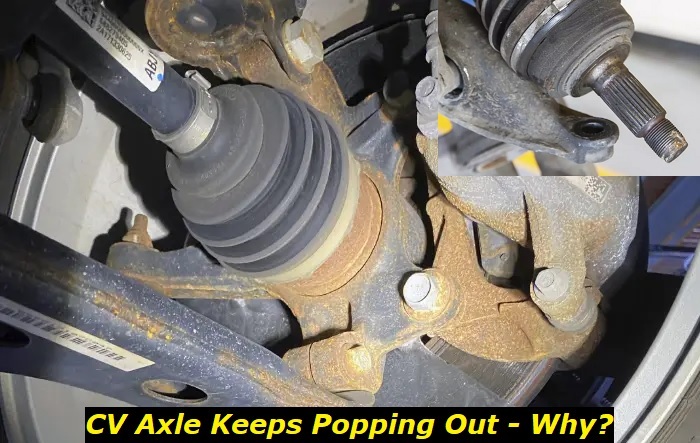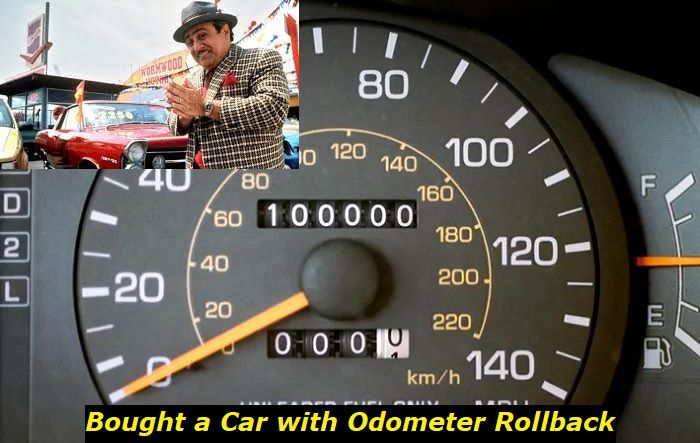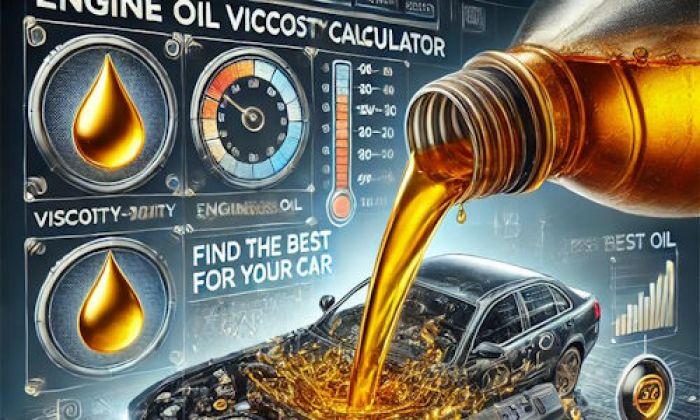The Constant Velocity (CV) axle, also known as the half shaft, plays a crucial role in moving power from your transmission and differentials all the way to the wheels. This ensures the proper acceleration, stability, and drivability of your vehicle.
Drive shaft problems highlights
- Level of importance:high
- Common reasons:old drive shaft, accidents, broken rubber protection
- DIY inspection:possible
- DIY repair:impossible
- Average price in shops:$250 - $500
- Average time:2 - 3.5 hours
- If ignored: no-drive, unpleasant sounds, hub wear

Most Common Causes of the CV Axle Popping Out
There are numerous factors that may dislodge the CV axle from its position. The following are the most common scenarios that can explain why this may happen and the effects of such a situation:
- Scenario 1: Worn Out Boots or Clamps
The CV axle of a vehicle is necessary for the efficient transmission of power from the engine to the wheels. It is an integral part of a car's drivetrain and usually consists of two CV joints that are connected by a shaft. The boots or clamps surrounding the CV joint are designed to keep dirt and debris out, but they can wear out over time due to road conditions, heat from driving, and chemical exposure. When this happens, it can cause the CV axle assembly to become loose and pop out of place.
The repercussions of such an occurrence can be catastrophic. Without a properly secured CV axle in place, power cannot be transmitted to the wheels. This can render the vehicle immobile and make it potentially hazardous on the road. Additionally, a dislocated CV axle can cause parts of it to become damaged due to being exposed to debris and dirt, leading to further issues and requiring more frequent replacements. With these things in mind, the boots and clamps of the CV axle must be replaced as soon as signs of heavy wear or damage become very evident.
- Scenario 2: Weak or Broken Axle Shaft
The axle shaft that connects the two CV joints together is designed to be strong enough for regular use over long periods of time, but it may become weak with age and lose its ability for secure attachment between both ends. It can also be broken if an excessive load is applied onto the hubs or if the car has been involved in a collision or similar accident.
Regardless of the cause, a weak or broken axle shaft can lead to the CV assembly popping out of place, preventing the transfer of power from the engine to the wheels. Thus, the replacement of the said parts is essential if signs of major wear or damage are already manifesting.
The consequences of a dislocated CV axle because of a weak or damaged axle shaft are similar to those mentioned above. Without a secure connection between both ends, power cannot be transferred efficiently and the vehicle may lose its capability to accelerate. Furthermore, if parts of it become exposed to various elements due to the dislocation, they can become damaged and require frequent replacement. In cases where an excess load has been applied onto the hub, extra repairs might also be needed for the vehicle to operate properly again.
- Scenario 3: Deformation of the Hub or CV Connectors
The hubs and connectors in the vehicle's axle assembly are designed to provide a secure connection between both ends of the CV axle. However, they can become deformed due to extreme temperatures, rust, overloading, and other factors. This can force them to lose their shape, resulting in an improper fit for the CV axle which could lead to it popping out of place.
The outcomes of such an event depend on how severe the deformation is. If it's only slight, then power may still be able to go from one end to the other. However, if it's more drastic, then this will render the car still until repairs or replacements are made. Moreover, the deformation can cause foreign objects to make their way into the axle assembly leading to further issues down the line. Therefore, it's important to seek out professional help as soon as possible in order to ensure that the vehicle remains safe and efficient.
- Scenario 4: Lack of Proper Maintenance
Finally, a lack of proper maintenance can cause the CV axle to pop out of place. This is because vehicles require periodic servicing for their components to remain secure and functioning properly. If regular check-ups are neglected and other necessary maintenance tasks aren't done, then this can lead to the CV axle becoming loose over time and eventually coming out of place.
The repercussions of this occurrence are similar to everything mentioned above. Without a securely fitted CV axle, power cannot flow efficiently and the car may lose its major function until repairs are made. Likewise, parts that become exposed due to a dislocated axle may need frequent replacement or repair for them to resume their optimal operation. Hence, it's important to follow a routine maintenance schedule to ensure that the vehicle remains in a good condition.
To take care of your CV axle, be sure to keep up with regular maintenance and check-ups, replace parts when needed, top up or flush out the dirty fluids of your auto, and take preventative measures to ensure that the axles remain securely in place. If you do experience a dislocated CV axle, then it's important to seek solutions as soon as possible in order to get it fixed before any further damage can occur. Doing so will not only keep your vehicle running safely but also efficiently for many years to come.
By following the tips above, you should be able to avoid unnecessary repairs and prolong the life of your CV axle. With proper upkeep, you can be rest assured knowing that your car will always be ready for your journeys.
Key Symptoms of CV Axle Problems
Overall, there are various scenarios that can lead to the CV axle of a vehicle popping out of place, including faulty or worn-out components, deformation of connectors and hubs, and lack of proper maintenance. The aftermath of each factor may vary depending on the situation but they largely consist of power not being able to be transferred efficiently from one end to the other, rendering the car stuck in place.
If this happens then it's important to seek professional help as soon as possible in order to get it fixed promptly and safely. In addition, regular check-ups and servicing should also be done to prevent similar instances from arising in the future.
On the other hand, prevention is always better than cure. So, one way to avoid the troubles discussed here is by watching out for early symptoms of malfunctioning, worn, or damaged CV axle, and these include the following:
- Vibration or shuddering when accelerating, braking, or turning
- Grinding noise coming from the axle area
- Dark and gritty fluid seeping out of the boot
- Difficulty in turning or steering
- Visible deformities on the CV joints
- Delays in acceleration every after shifts
Again, if any of these signs are noticed then it's best to seek professional help immediately to avoid further issues. With this knowledge, you should now be able to keep your vehicle running safely while also extending its life span.
Cost of CV Axle Replacement
Failure to fix any problem associated with the CV axle in due time is almost certain to lead to more expensive repairs or replacements in the end. The cost of a CV axle replacement varies depending on the make, model, and year of the vehicle plus other factors.
A conservative estimate of this is somewhere between $100 to $150 for each axle replacement for economy cars, including labor. Meanwhile, the prices can easily go up from $300 to $1,500 for each axle replacement for high-end units, inclusive of labor.
The figures don't include yet the other possible repairs or parts replacements for other parts of the drivetrain and the transmission that may be compromised as a result of the issue.
Conclusion
To sum it all up, CV axles are designed to provide power transmission between two connected hubs while also providing protection against dirt, debris, and other contaminants entering the system. When these components become worn out, however, they can lead to the CV axle popping out of place due to a lack of secure connection between both ends.
A CV axle tends to pop out of place because of the listed factors. Typically, the results of such incidences are a lack of power transmission from one end to the other, increased wear on parts due to exposure to dirt and debris, and potential immobility. Likewise, it can lead to further damage to the other components of the vehicle starting with the parts of the drivetrain and the transmission systems.
Drivers should be aware of the scenarios shown here for them to properly maintain their vehicles and keep them safe on the road. Lastly, it is important to address such issues as quickly as possible.
About the authors
The CarAraC research team is composed of seasoned auto mechanics and automotive industry professionals, including individuals with advanced degrees and certifications in their field. Our team members boast prestigious credentials, reflecting their extensive knowledge and skills. These qualifications include: IMI: Institute of the Motor Industry, ASE-Certified Master Automobile Technicians; Coventry University, Graduate of MA in Automotive Journalism; Politecnico di Torino, Italy, MS Automotive Engineering; Ss. Cyril and Methodius University in Skopje, Mechanical University in Skopje; TOC Automotive College; DHA Suffa University, Department of Mechanical Engineering






Add comment